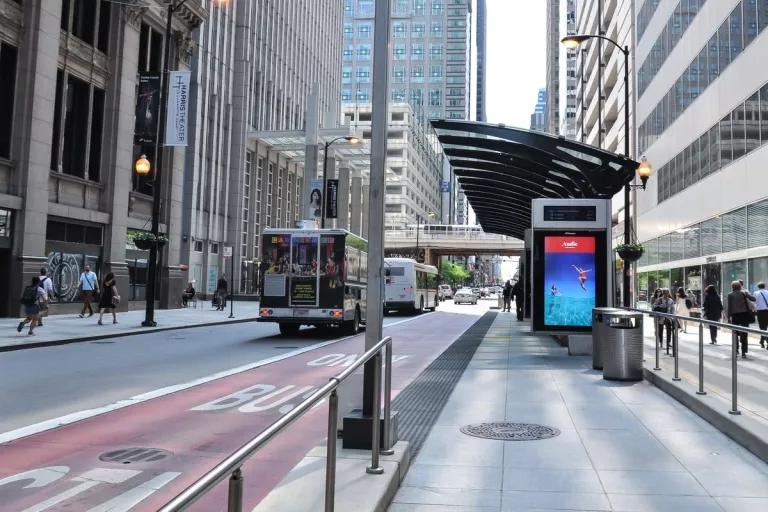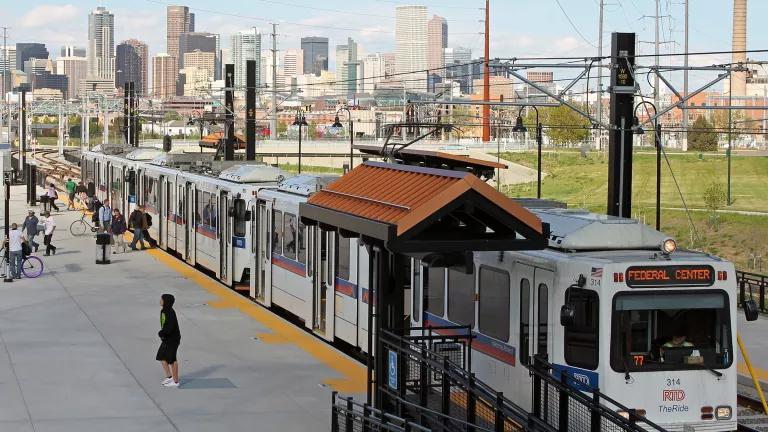Chicago to Tackle Congestion and Transportation Inequity

This blog was co-authored with Mary Nicol, Climate Advisor to the City of Chicago.
Mayor Lightfoot recently introduced one of the country’s most ambitious and equitably structured proposals to price ride-hailing trips, underscoring the city’s commitment to reducing congestion and investing in high-quality transit service for residents all across Chicago.
The proposal is designed to reduce congestion and improve bus service by increasing taxes on all ride-hailing trips in Chicago’s congested core, and on non-shared ride-hailing trips throughout the city. The city plans to reinvest a portion of the revenues into making bus service more reliable to improve transportation options for all Chicagoans and turn around declining bus ridership.
With the Mayor’s proposal, high-income residents are likely to bear much of the fiscal impact. The ride-hailing passengers who will see the biggest price increases will be those who choose to travel by car alone in the downtown zone. Shared rides taken outside the downtown zone, late at night, or on weekends will see a price drop.
It has been a well-publicized fact that gridlock in Chicago is getting worse, with vehicle slowdowns experienced citywide, including a recent spike downtown where average speeds decreased by 2.3 percent from 2016 to 2017. There are a number of factors that contribute to traffic congestion, with the relatively recent ascent of the ride-hailing industry being one of them. Over the last three years, the city reported a record 271 percent increase in the use of ride-hailing trips offered by Transportation Network Provider (TNP) companies like Uber, Lyft, and Via. Although Chicago residents have had greater access to the city since the introduction of these services, their growth has also contributed to significant increases in traffic congestion and air pollution in the city.
The Mayor’s proposal makes even more sense when taking a closer look at the detailed report on the effects of TNP companies on congestion recently released by the city. Nearly half of all ride-hailing trips begin or end in the downtown zone, with only 20 percent of these trips requested as shared trips. This competes with cleaner, more efficient transportation options such as the train, bus, bike, or walking, and contributes to poorer air quality and more congestion. As one of the 25 Bloomberg American Cities Climate Challenge cities, Chicago is taking a leadership role in addressing these negative environmental and social impacts.
How Mayor Lightfoot’s Proposal Addresses Congestion Head-On
Mayor Lightfoot’s proposal would create a “downtown zone surcharge” that will be added to both shared and non-shared rides in the downtown zone. Currently, the ground transportation tax sits at $0.60 for all rides, independent of place or time. The surcharge will be added to rides on weekdays from 6am to 10pm, during which time traffic congestion is at its worst downtown. Shared rides starting or ending in the downtown zone will be assessed a $1.13 total tax during surge times, and non-shared rides a total tax of $2.88. Outside the downtown zone, shared ride taxes will decrease to $0.53, while non-shared rides will be assessed $1.13. For TNP users choosing non-shared rides outside the downtown zone, there will be an 88% increase in the ground transportation tax under the proposed fee structure.
Yet passengers will benefit from an almost 12% reduction in the ground transportation tax for shared rides outside of the downtown zone—providing an important equity benefit to city residents. This is especially important for riders on the South and West sides, where nine out of ten trips go from neighborhood to neighborhood, never entering (nor contributing to congestion in) the downtown zone. Half of these are also requested as shared rides, significantly higher than the city’s average ride-sharing rate. The city reported that only five percent of the rides to Englewood go downtown—out of 400,000 annual trips.
A few existing special cases will be preserved. Ride taxes for Chicago “Special surcharge zones,” McCormick Place, Navy Pier, and O’Hare and Midway airports will remain the same at $5.00 per ride. This proposed tax increase will not affect Wheelchair Accessible Vehicles, nor will they be subject to the downtown zone surcharge.
Taken together, these changes will incentivize customers to share rides in Chicago while at the same time investing in the city’s bus system, a more reliable and efficient alternative to driving.
Fewer Cars; Faster, More Reliable Buses
This increased tax on TNPs will fund much needed public transportation improvements, making bus service in particular more reliable and accessible to Chicago residents.

The city projects that the proposed congestion pricing will generate over $40 million annually. About $2 million of these funds will be allotted to improving seven priority bus lanes on Chicago’s South and West sides, areas with some of Chicago’s highest-ridership bus routes. These include Halsted Street (#8), Western Avenue (#49), Pulaski Road (#53), 63rd Street (#63), Chicago Avenue (#66), Belmont Avenue (#77) and 79th Street (#79). Access to fast, frequent, affordable, and reliable public transportation is vital to Chicago’s communities. This proposal addresses the challenges many Chicagoans face with limited access to transportation options and unreliable service and demonstrates Mayor Lightfoot’s commitment to making transit work better in communities that need it most.
Equity in Access to Transportation
The city has been working continuously to ensure that residents of Chicago have equitable access to transportation in the city, and the Mayor’s recent proposal is part of a larger strategy designed to improve affordable, high-quality, low-emission transportation options and reduce congestion. The proposal also aligns with Mayor Lightfoot’s platform for Equitable and Efficient Transit.
This year, CTA increased the frequency of bus routes, specifically for those traveling to the South side of Chicago. Their proposed budget for 2020 includes a $310 million dollar investment for the Red Line Extension project. The Red Line Extension project will extend the Red Line 5.3 miles south adding four new, fully accessible stations at 103rd Street, 111th Street, Michigan Avenue, and 130th Street. The project will cost about $2.3 billion total.
Further, the city’s bikeshare network, Divvy, is expanding their access to bikes into the Far North and South sides. By 2021, more than double the current number of bikes will be added to all 50 Chicago wards. 30 new stations will also be added to the neighborhoods of Roseland, Chatham, Morgan Park, Beverly, Washington Heights, Pullman and Auburn Gresham, to hold a total of over 500 new pedal bikes.
Moving Forward
The path to a cleaner, less congested, and more equitable transportation future requires a bold vision and strong leadership. Chicago is leading the way.


